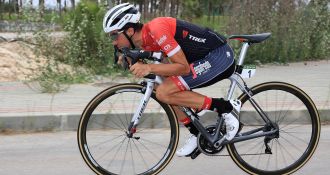

As devoted road cyclists, we are constantly striving to go faster. Hill repeats, long winter turbo sessions, intervals; whatever the method, training our legs to cope with the pain is part and parcel of cycling. However, even the most hardened roadie needs a shortcut every now and then, and thankfully optimising aerodynamics is a fast, simple and, most importantly, legal way to knock time off your personal bests. Here’s our guide to getting aero on a road bike:
Products: 36509, 39780
Position
The rider the most significant mass that needs to be dealt with when it comes to aerodynamics. So before you look at investing in some aero gear, see if your position on the bike could be tweaked. The key here is to create a surface area that is as small as possible so as to punch a minimal hole in the air ahead of you. Sitting high with your hands on the tops of your bars will increase drag and slow you down. Riding on the drops will not only reduce your frontal area, but will flatten your back and allow air to more smoothly pass over you.
Bike
If you live in a largely flat area, it may be worth considering a more aerodynamic frame when the time comes for a bike upgrade. Nearly all manufacturers offer a frame that sits somewhere between their lightweight climbing frame and their time trial frame in terms of aerodynamics. Whilst likely to be heavier than some road frames, you’ll save valuable watts on the flat. Even more affordable is a set of deep-section wheels, which funnel air more efficiently than your standard shallow-rimmed road wheel. The Trek Madone is designed with aero in mind, and this one comes with Bontrager Aeolus 5 50mm wheels, which are deep enough for an aero gain, but shallow enough to ride in the wind without getting sideswiped by a sudden gust.
Kit
Cycling kits are made from lycra in part for its aerodynamic properties, though some kits are more aero than others. Whilst a tighter fit is better, it’s not simply a question of swapping your large jersey for a medium one. Instead, focus on your accessories; there are little gains to be had everywhere. Much research has gone into the optimal sock length for aerodynamics – some track riders and time trial specialists have ridden with no socks at all – whilst overshoes will smooth out the bumps on your shoe buckles. It may not seem like it does much, but it all adds up to a more efficient ride, and it could make all the difference when it comes to a Strava KOM or a race.
While there’s no substitute for training, there’s no reason not to embrace the free speed that science now offers us, and get aero.